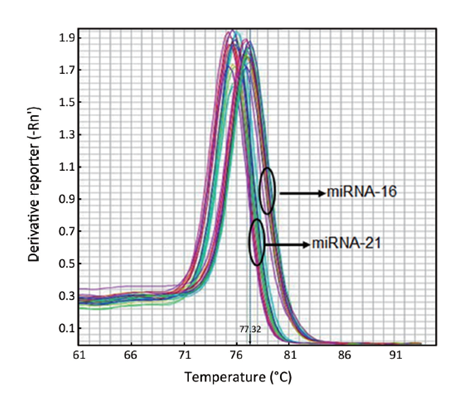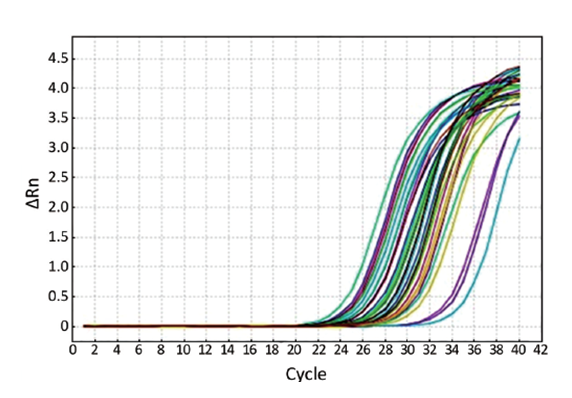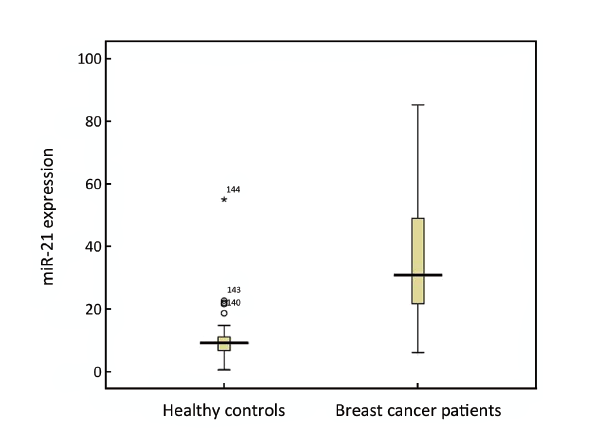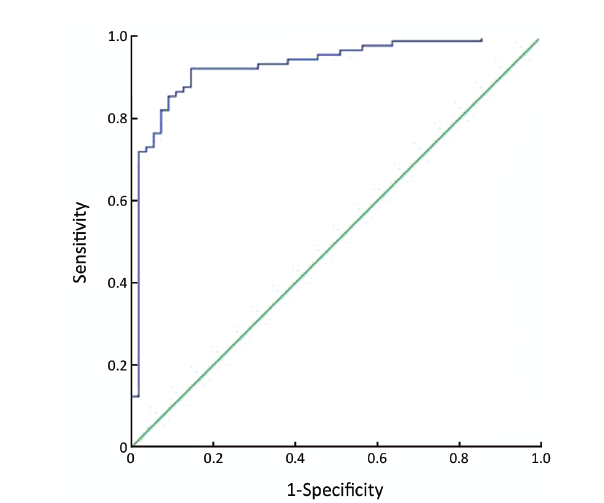Research article / Open Access
DOI: 10.31488/bjcr.188
Clinical Significance of Serum miR-21, CA153 and CEA in Breast Cancer
Bezal Bezal
University of sulaimany, Iraq
*Corresponding author:Bezal Bezal, University of sulaimany, Iraq
Abstract
Objective: one of the essential regulators of carcinogenesis is MicroRNA-21 (miR-21). Yet little light has been shed on its effectiveness as a tumor marker compared to the conventional ones. Comparing the diagnostic value of established tumor markers in breast cancer (BC) such as carcinoembryonic antigen (CEA) and CA153 with circulating level of miR-21 is the aim of this study.Methods: The study included 89 BC patients. Amplification of the circulating levels of miR-21 and miR-16 done using real-time PCR qualitative detection, while electrochemiluminescence assays was used to detect circulating levels of CEA and CA153. The diagnostic sensitivity for BC was compared between the three.Results: the serum miR-21 levels were high significantly BC patients, as the latter had much higher levels (P<0.001). the CA153 and CEA sensitivities were 15.73% and 22.47% respectively, while miR-21 Sensitivity and specificity were 87.6% and 87.3%.Conclusion: in BC patients miR-21 exhibits far higher sensitivity for diagnoses than both CEA and CA153. Thus especially in the early stages of BC, miR-21 can become a potential indicator for diagnosis, albeit the clinical stage, PR and ER statuses were not correlated in this study.
Keywords: real-time polymerase chain reaction (real-time PCR); breast cancer (BC); MicroRNA-21 (miR-21)
Introduction
Cancer is one of the illnesses where the stage at which the disease is diagnosed plays a crucial rolepatients survival and quality of life [1]. A diagnostic indicator that can detect cancer in early stages is of great significance, especially for breast cancer (BC), as it is the most common cancer in woman [2]. One field of interested is that of tumor markers, due to their noninvasive, rapid and simple nature [3].
Despite their low sensitivity and specificity, the carcinoembryogenic antigen (CEA) and cancer antigen 153 (CA153) are the commonest markers used. MicroRNAs are found to have close ties with development and formation of tumors and are involved in regulating many cellular processes. They are a class of noncoding RNAs composed of 19-25 nucleotides [4].
miR-21 is involved in oncogenic process and has been demonstrated to be an essential regulator, and due to its involvement in tumor formation, its level is raised in majority of human tumors. The overexpression of miR-21 in BC tissue was noticed by Iorio et al. [1] and suggested it can be an effective marker; however getting tissue is an invasive procedure. Easy monitoring, little invasiveness and simple collection is an obvious advantage of serum sampling [5,6].miR-21 expression was evaluated in 89 BC patients using SYBR-Green as a base and miR-16 as reference for the stem-loop real-time reverse transcription-polymerase chain reaction (RT- PCR) [7]. Considering the hormone receptor status and disease stage, miR-21 expression levels were compared, and then its sensitivity for diagnosing BC was pitted against CEA and CA153.
Materials and Methods
Subjects
The study was performed in Kurdistan Hospital and approved by its Ethic committee. All patients agreed to a written informed consent. The BC women confirmed by medical examination were aged between 28 to 60 years, with 50 as a median age and blood samples were collected from March 2011 to April 2011. All the patients had a confirmed diagnosis for primary BC by histology and were undergoing therapy at the time of study, aged between 29 and 40 years, with 36 as a median age. Samples were collected between March 2011 and May 2011.
miR-21 detection
Serum samples and total RNA preparation
The samples were stored until processing at 80 ℃. Adhering to manufactures instructions, the TRIzol reagent from Invitrogen life technologies was used for extraction of total RNAs from serum.
Reverse transcription
Each 10 mL RNA sample was mixed with 3 mL stem-loop RT primers of miR-16 and miR-21, and 4 mL of 5× RT Buffer, 1 mL of Moloney murine leukemia virus (M-MLV) reverse transcriptase [Promega (Beijing) Biotech Co., Ltd.], 0.5 mL of dNTPs [Tiangen Biotech (Beijing) Co., Ltd]. ,0.2 mL of RNasin [TiangenBiotech (Beijing) Co., Ltd.]., and 2 μL of 1 mol/L dithiothreitol [DTT; Tiangen Biotech (Beijing) Co., Ltd.] were added (Table 1). The final volume of the mixture was 20.7 L and incubated at various temperatures for different durations, at 61℃ for 30 min, 73℃for 30 min and 170 ℃ for 10 min, and lastly was held at 4 ℃.
Table 1.Reverse transcription reaction system
| Reagent | Volume (µL) |
|---|---|
| Total RNA | 10.0 |
| RT primer | 3.0 |
| 5x Buffer | 4.0 |
| 1 mol/L DTT | 2.0 |
| RNasin | 0.2 |
| dNTPs | 0.5 |
| M-MLV | 1.0 |
Real-time PCR
1.6 μL cDNA is the product of reverse transcription, and this product is mixed with 10 μL SYBR Green Master (Roche Co., Ltd.) and 1 μL PCR primers along with other PCR reagents (Table 2). The entire reaction was performed in the ABI 700 Fast PCR system, the conditions for the PCR was denaturing for 10 min at 95 ℃, after which 40 cycles of 95 ℃ for 15s is applied, followed by 60 ℃ for 1 min.
Table 2.Real-time PCR system
| Reagent | Volume (µL) |
|---|---|
| SYBR Green Master | 10.0 |
| Forward Primer | 1.0 |
| Reverse Primer | 1.0 |
| DNA template | 1.6 |
| DFPC water | 6.4 |
| DEPC, diethylpyrocarbonate |
CEA and CA153 detection
electrochemiluminescence assays was used to calculate CEA and CA153 levels and through Roche E170 MODULAR Immunoassay Analyzer the reaction is carried out.
Statistical analysis
Using relative change folds, normalization of circulating miR-21 expression was done. The characteristics of miR-21 relative expression levels is their range from 25th to 75th percentile and by their median. The connection of patient’s hormone receptor status with their miR-21is analyzed with mann-whitney test, while the association with of their clinical stage with their miR-21 is calculated through Kruskal-Wallis test. Mann-whitney test was also used to measure miR-21's expression between healthy and BC individuals. The receiver operating characteristic curve (ROC) was used to determine the cut-off value, which was used to identify the specificity and sensitivity values. SPSS 16.0 software was used for all statistical anaylysis and statistically significant threshold was set as P <0.05.
Results
Target gene amplification
Pure homogenous products of miR-21 and miR-16 from PCR was obtained (Figure 1), as indicated from their melting curves (Figure 2) with narrow peak and sharply defined curves.

Figure 1:The melting curve of miR-21 and miR-16

Figure 2:The amplification curve of miR-21 and miR-16
The expression of miR-21 in BC
miR-21 expression was evaluated in in 89 BC diagnosed patients. The patients showed high level of miR-21 which was significantly high among BC patients (30.82), resulting in (P < 0.001) with a ratio of 3.39 (Figure 3).

Figure 3:miR-21 expression in breast cancer patients and healthy controls
miR-21 ROC curve
13.22 was the best designated cut-off value, and 92.9% was determined to be the area under ROC curve (ROC-AUC) (95% confidence interval: 88.3%, 97.4%), while 87.6% and 87.3% were sensitivity and specificity values respectively, as shown in (Figure 4).

Figure 4:The ROC curve for miR-21
Clinical and pathological feature's association with miR021 expression levels
According to status of hormone receptors and clinical stage of the patients, they were classified into groups and miR-21 median expression level is shown according in table 3. However, no correlation was observed between patient's clinical stage and hormone receptor statuses against their miR-21(P>0.05).
miR-21 comparison with traditional tumor markers CEA and CA153
Patients are grouped into different classes according to their clinical stage in table 4, and listing their CEA, CA153 and miR-21 median expression levels. Significant difference is detected as the overall sensitivity of CEA and CA153 were merely 15.73% and 22.47% respectively, while miR-21's overall sensitivity was 87.64%. Particularly in early stage (stage I), the sensitivity of CEA and CA153 is only (4.76%), while miR-21 boasts a marked diagnostic sensitivity of (95.24) (Table 4).
Discussion
It is 19-25 nucleotides that make up the molecule of miRNAs, Small indeed, but various biological signaling pathways are regulated by them [8]. The close relationship between the many characteristics of tumors including their development, invasion and metastasis and miRNA has been demonstrated by many studies, and in cancer therapy, this could be a bases for entirely new strategies to fight cancer [9]. Many malignant tumors have shown increased miRNA serum expression [10]. And as a diagnostic and prognostic marker, it has been getting increasingly more attention.
It is to no surprise that an early diagnostic indicator for the commonest cancer among woman, that is BC, is of great value, affecting prognosis. Due to their simple and less invasive nature, serum markers are the focus of interest. Despite their low sensitivity and specificity, especially in early stages [11], CEA and CA153 are still commonly used in BC patients monitoring, since relapse is associated with high levels of these markers. Furthermore, CEA cannot be used in diagnosis early stages of BC, since it has a lower positive rate, and it is a nonspecific tumor marker.
Differential expressions of some miRNA in normal and BC tissues has been demonstrated recently, such as let-7a(8), miR-21, and miR-145 [12]. In BC cells, they take care of biological process regulation, and various roles in apoptosis and proliferation. The possibility of miRNA acting as a BC tumor marker for diagnositic and therapeutic purposes as been reported recently [13].
miR-21 has independent transcriptional units [10] and is located on 17q23.2. it has shown significant role in colon cancer development [10,11], lung cancer development [12,13], as well as stomach cancer [15] and finally BC et al.[13], as it partakes in expressing and regulating numerous tumor suppressor genes. Many studies have used various methods such as Northern blotting,in situ hybridization (ISH), microarray, the profiling method of flow cytometric miRNA expression that is bead based, and finaly RT-PCR (20-23) to prove that in BC, miR-21 is up-regulated both in in vitro and in vivo. And a preliminary study about miR-21 overexpression in BC tissue has been taken (1,21,24-26).The conclusion of the study was that miR-21 expression is correlated with pathological and clinical variables in BC tissues, and it is expression was higher than normal breast tissues [12]. Yet the study avoided the discussion of practical value of this finding in diagnosis of BC. In addition to the fact, that breast tissue was the center of previous studies, and little was mentioned about miR-21 serum levels, which is the focus of our study. miR-21 serum expression levels in BC patients was evaluated using stem-loop real-time RT-PCR which is based on SYBR-Green, and addressed the application of miR-21 as a diagnostic and monitoring marker in BC patients. The miR-21 expression level was (3.39) times higher in BC patients, which is statistically significant (P<0.001). Moreover in the diagnosis of BC, the miR-21 has demonstrated sensitivity and specificity of 87.6% and 87.3% respectively, which shines in comparison to traditional marker's sensitivity of CEA and CA153, that were merely 15.73% and 22.47%. our study also showed that there no correlation between clinical stages and miR-21 serum expression, as well as no correlation between hormone receptor statuses (Progesterone receptor and Estrogen receptor ) and miR-21 expression. Similar results was reported by other studies [11].
In conclusion, the new serum marker miR-21 topples traditional serum markers like CEA and CA153 in sensitivity, which can improve prognosis of BC by allowing earlier diagnostic sensitivity. miR-21 can be addressed as a potential early stage BC serum tumor marker. We will have a follow up study to this preliminary study, where we will have more in-depth analysis and increase the sample size, hopefully becoming a good basisfor miR-21 as a diagnostic tool in BC [9].
References
1. Iorio MV, Ferracin M, Liu CG, et al. MicroRNA gene expression deregulation in human breast cancer. Cancer Res.2005;65:7065-70.
2. O'Hara SP, Mott JL, Splinter PL, et al. MicroRNAs: key modulators of post-transcriptional gene expression. Gastroenterol.2009;136:17-25.
3. Chou J, Shahi P, Werb Z. microRNA-mediated regulation of the tumor microenvironment. Cell Cycle.2013;12:3262-71.
4. Zhang B, Pan X, Cobb GP, et al. microRNAs as oncogenes and tumor suppressors. Dev Biol. 2007;302:1-12.
5. Zheng DL, Haddadin S, Wang Y, et al. Plasma microRNAs as novel biomarkers for early detection of lung cancer. Int J Clin Exp Pathol.2011;4:575-86.
6. Samy N, Ragab HM, El Maksoud NA, et al. Prognostic significance of serum Her2/neu, BCL2, CA15-3 and CEA in breast cancer patients: A short follow-up. Cancer Biomark.2010;6:63-72.
7. Wu ZC, Zhai HS, Yan CL, et al. The value of serum CA15-3, CEA in the early diagnosis of breast cancer. Qiqihar Yi Xue Yuan Xue Bao (in Chinese).2010;31:1849-50.
8. Song EW. Small molecule RNA for basic research and clinical applications. Beijing: Science and Technology Press. 2007:115-20.
9. Si H, Sun X, Chen Y, et al. Circulating microRNA-92a and microRNA-21 as novel minimally invasive biomarkers for primary breast cancer. J Cancer Res Clin Oncol.2013;139:223-9.
10. Fujita S, Ito T, Mizutani T, et al. miR-21 Gene expression triggered by AP-1 is sustained through a double-negative feedback mechanism. J Mol Biol.2008;378:492-504.
11. Slaby O, Svoboda M, Fabian P, et al. Altered expression of miR-21, miR-31, miR-143 and miR-145 is related to clinicopathologic features of colorectal cancer. Oncol.2008;72:397-402.
12. Schetter AJ, Leung SY, Sohn JJ, et al. MicroRNA expression profiles associated with prognosis and therapeutic outcome in colon adenocarcinoma. JAMA.2008;299:425-36.
13. Yanaihara N, Caplen N, Bowman E, et al. Unique microRNA molecular profiles in lung cancer diagnosis and prognosis. Cancer Cell.2006;9:189-98.
14. Markou A, Tsaroucha EG, Kaklamanis L, et al. Prognostic value of mature microRNA-21 and microRNA-205 overexpression in non-small cell lung cancer by quantitative real-time RT-PCR. Clin Chem.2008;54:1696-704.
15. Volinia S, Calin GA, Liu CG, et al. A microRNA expression signature of human solid tumors defines cancer gene targets. Proc Natl Acad Sci USA.2006;103:2257-61.
Received: December 5, 2023
Accepted: January 3, 2024
Published: January 8, 2024.
To cite this article : Bezal Bezal. Clinical Significance of Serum miR-21, CA153 and CEA in Breast Cancer. British Journal of Cancer Research. 2024; 7(1): 644- 647. doi: 10.31488/bjcr.188.
© The Author(s) 2024. This is an open access article distributed under the terms of the Creative Commons Attribution License (https://creativecommons.org/licenses/by/4.0/).
